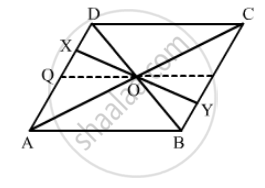Advertisements
Advertisements
प्रश्न
If an angle of a parallelogram is two-third of its adjacent angle, find the angles of the parallelogram.
उत्तर
\[\text{ Two adjacent angles of a parallelogram add up to } 180° . \]
\[\text{ Let x be the angle } . \]
\[ \therefore x + \frac{2x}{3} = 180°\]
\[\frac{5x}{3} = = 180°\]
\[x = 72°\]
\[\frac{2x}{3} = \frac{2 \times 72°}{3} = 108°\]
\[\text{Thus, two of the angles in the parallelogram are 108° and the other two are }72° .\]
APPEARS IN
संबंधित प्रश्न
ABCD is a parallelogram in which ∠A = 70°. Compute ∠B, ∠C and ∠D.
Two adjacent sides of a parallelogram are 4 cm and 3 cm respectively. Find its perimeter.
Diagonals of parallelogram ABCD intersect at O as shown in the following fegure. XY contains O, and X, Y are points on opposite sides of the parallelogram. Give reasons for each of the following:
(i) OB = OD
(ii) ∠OBY = ∠ODX
(iii) ∠BOY = ∠DOX
(iv) ∆BOY ≅ ∆DOX
Now, state if XY is bisected at O.

Fill in the blank, in the following, so as to make the statement true:
A rhombus is a parallelogram in which ......
The diagonals of a quadrilateral are perpendicular to each other. Is such a quadrilateral always a rhombus? If your answer is 'No', draw a figure to justify your answer.
Which of the following statement is true for a rectangle?
Its diagonals are equal and bisect each other.
The given figure shows a rhombus ABCD in which angle BCD = 80°. Find angles x and y.

If all sides of a quadrilateral are equal, it is a ______.
Diagonals of a quadrilateral are perpendicular to each other. Is such a quadrilateral always a rhombus? Give a figure to justify your answer.
ABCD is a rhombus such that the perpendicular bisector of AB passes through D. Find the angles of the rhombus.
Hint: Join BD. Then ∆ABD is equilateral.
